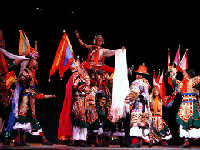 |
|
A performance ofKing Gesar
|
Gesar's image and story are immortalized in carvings, paintings, murals, woodcuts, embroideries, songs, dances and plays. Tibet has a research institute specializing in the study of the epic, whose research projects are listed as key State projects. Since 1979, the institute has collected more than 180 different song and narration versions of the epic, 55 woodblock and mimeographed editions and has recorded 70 performances of the epic on more than 3,000 recording tapes. Since liberation, China's related research institutes have been working on this monumental portion of world literature by gathering, sorting, collecting, studying and publishing the material on a large scale.
 Plots
Plots
The story is set in the distant past, when the common people of the Tibetan plateau were subjected to many natural disasters and calamities. Demons and spirits ran wild. In hopes of helping the people The Goddess of Mercy asked the Amitabha Buddha to send the son of the God of Heaven to the world to defeat the evil demons.
Toiba Gawa, who later came to be known as Gesar, descended upon the earth and became king of the Tibetan people. With his great abilities to defeat the demons and aid the poor and common people, Gesar was portrayed as a combination of god, dragon and a fierce spirit known as nyan in primitive Tibetan religion. He was endowed with special characteristics and marvelous powers and abilities, also suffering several trials. However, his invincible powers and protection from the God of Heaven helped him to survive and eventually defeat the demons.
Throughout his human life, Gesar labored to abolish the scourges that plagued the lives of the common people. At the age of five, he moved to the banks of the Yellow River with his mother. When he was eight, they were joined by the members of the Ling tribe. Winning a horse race against the finest tribe warriors at the tender age of 12 led to his position as chief. Gesar then married Sengjam Zholmo and led expeditions against his enemies, defeating the northern demons that had invaded the Ling Kingdom. In successive campaigns, Gesar defeated King Gurdkar of the Hor Kingdom, King Sadam of the Jiang Kingdom, King Shingkhri of Monyul, King Nor of Tangzig, King Chidan of Khachevigyu, King Toigui of the Zugu Kingdom and scores of other small tribes and minor kingdoms known aszongsin ancient Tibet. After completing his sacred mission, Gesar returned to heaven together to join his mother and wife, bringing the grand epic of his life to a dramatic close.
